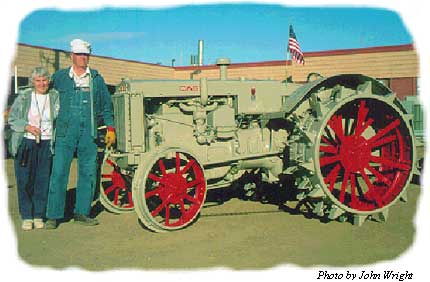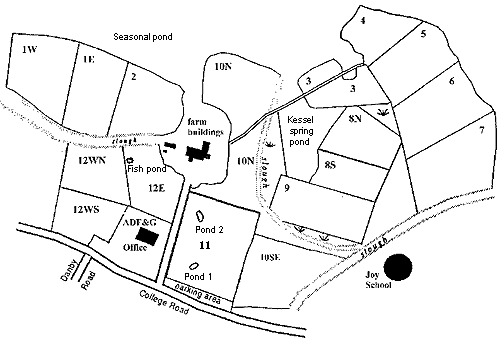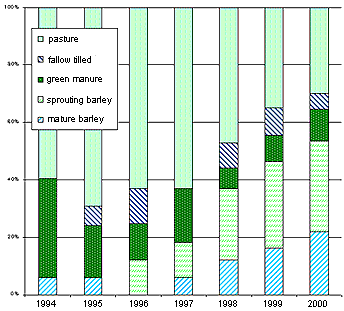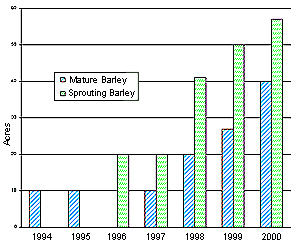Creamer's Field —
Migratory Waterfowl Refuge
Farming Operations

| Annual Summary | History of Creamer's | 2000 Farm Season | General Results |
| Creamer's Field Migratory Waterfowl Refuge | Dedication | ||
Annual Summary
Farming for the benefit of wildlife is the goal of the agricultural program at Creamer's Field Migratory Waterfowl Refuge. We are attempting to increase the carrying capacity for waterfowl and cranes in both terrestrial and aquatic habitats on the Refuge by using several new management techniques. In 2000 the total acres actively farmed (excluding pasture) at Creamer's Refuge was 127 acres, compared to 108 acres in 1999 and just 67 acres in 1994.
In 2000 we continued farming at Creamer's using the sustainable agriculture techniques ADF&G staff began to apply in the early 1990s. These techniques involve no fertilizers or pesticides. We planted only a single variety of barley, otal, in the 2000 season, and treated fields of mature barley by cutting and leaving entire sections just before the onset of fall bird migration in August. Approximately 40 acres of mature barley were planted in 2000, compared to 27 acres combined of the thual and otal varieties in 1999.
We planted 57 acres with otal barley late in summer 2000 to grow sprouts for geese. By comparison, 50 acres of late-sprouting barley were planted in 1999. Mid and late summer rainfall was probably the most instrumental factor in the good production of sprouting barley for the fall migrants at Creamer's Fields in 2000.
Twelve tons of feed grain was spread during fall 2000, with the majority in Field 11 (the front viewing field) between mid-August and mid-September. By comparison, 8 tons of feed barley had been placed in these fields in fall 1999. In spring 2000, 6.7 tons of feed barley was spread, 30-50% more than was provided in previous years.
By providing fields of mature and sprouting barley, spreading feed barley, keeping pastures cut short, as well as constructing a new permanent pond in the front viewing field, we attracted near record numbers of cranes and geese to the Refuge in 2000. We recorded over 1925 cranes and 2010 geese at the Refuge in counts completed on single days in late August 2000. These figures were just below last year's record numbers. Over a thousand ducks concentrated near the new pond in the front viewing field in late August 2000. Ducks had not been seen previously in such large numbers on the Refuge in the fall.
Some fields at Creamer's were again set aside for soil improvement in 2000 in which we tilled under green crops to add organic matter to the soil. We treated 20 such acres in 2000 compared to 15 acres in 1999. For example, 5 acres of Field 8 was planted to barley, which was then turned over as green manure before the field was planted to barley sprouts for grazing waterfowl in fall.
We also continued to clear secondary successional brush and young trees from fields remaining in pasture. We used archival photographs from the time when the dairy was in operation as reference for restoring the fields to their original open conditions. In summer 2000, a line of trees that had grown up between Fields 4 and 5 was removed. This was done to encourage use of this corner of the Refuge by cranes and geese.
In fall 2000 we installed a second pond with liner on the north side of Field 11 (the front viewing field), based on the demonstrated success of the first lined pond constructed in 1999, to attract thousands of ducks to a central viewing area.
Based on these recent successes in attracting birds to Creamer's, we plan to continue similar levels of barley production at Creamer's while testing additional forage crop varieties, clearing encroaching brush, and ensuring maintenance of soil nutrients through crop and pasture rotation. We are also considering further restoration or construction of additional aquatic habitat.
Background
Brief History of Creamer's Farming
During the period when the Dairy was in operation (prior to 1966), the fields were planted in field peas and oats, which were cut and used as silage to feed the dairy cows. At that time hay for the dairy was produced on land along Farmer's Loop Road. Photographs from that era indicate the 450-acre farm was essentially treeless at the time, except for a few trees adjacent to the farm buildings. Many of the fields reverted back to brush after the Dairy closed. Parts of the farm acreage were sold off (approximately 200 acres in total) to become the Flodin sawmill property to the west, and Joy School and the Wedgewood Apartments to the east. When ADF&G took over management of the remaining 250 acres of former dairy fields, hay became the main crop produced on the Refuge, although some grain was grown. Although the hay fields provided little in the way of food for waterfowl, they did provide open space for cranes and geese, which prefer to feed and roost where they have good visibility of approaching predators. During the late 1980s, encroaching brush was eliminated from most of the hay fields. By 1993 approximately 135 acres were in pasture for hay production.
In 1994-1995 Division of Forestry firefighters cut back 30-years growth of encroaching balsam poplar from the edges of the fields, especially along the northern peripheries of Fields 1, 4, 7, and 10 . The remaining tree roots at the edge of each field were then removed using a road grader equipped with a ripper. The periphery of each field is now disced each year with a farm tractor to retard encroachment, and provide fire control lanes. In 1997 approximately 5 acres of 30-year second growth of willows, balsam poplar, and birches were removed from the area surrounding a seasonal pond located between Fields 3 and 10 . This clearing was done in order to restore waterfowl and shorebird use of the seasonal pond. This area attracts hundreds of waterfowl in spring, yet becomes dry by late June.
2000 Farm Season
In the 2000 season we increased the acreage managed intensively for waterfowl forage crop production, removed additional brush and trees from the fields, and installed a second, larger pond in the front viewing field. We continued growing both mature grain for cranes and late-season sprouting barley for geese. We improved soil quality on selected fields by means of a nitrogen-fixing clover crop and plowing under green manure crops.

The section below summarizes the results of the 2000 farming season, field by field (see map, Fig 1, above). Recommendations for 2001 are given for each field. Recommendations were developed in discussions between Ron Riesgaard, John Wright, and Sam Patten.
Field 1W - Field 1W was burned in May and was maintained in pasture through the 2000 season ( Table 1 ).
Recommendation: Field 1W, because of its position (away from the barn structures, yet with good access) has been burned as part of Division of Forestry spring training exercises more frequently than any other field at Creamer's. Repeated annual burning at this latitude may eventually exhaust soil nutrients. Recommend do not burn Field 1W in 2001. Instead of burning in 2001, we recommend rototilling the field to recycle dead grass and kill regenerating poplar stems. This will be done in preparation for conversion of this field from pasture to crop production in 2002.
Field 1E - Field 1E was disced and planted on May 26, 2000 to otal barley at 130#/acre to produce mature grain. Strips were mowed through the field on August 21, with a portion of mature barley left standing.
Recommendation: Field 1E should remain fallow early but be planted to barley sprouts in late July.
Field 2 - Field 2 was left fallow until planted to otal barley for sprouts at two intervals in 2000, the first on July 28 and the second on August 4. The common border between Fields 1E and 2, with swathed mature barley adjacent to sprouts, saw heavy use by waterfowl during the fall 2000 season.
During the Dairy operations prior to 1966, cow manure from the barns had been dumped on a small section of Field 2 crossed by the present Seasonal Wetlands Trail. This northern portion of Field 2 remained in rough pasture in 2000 even after being rototilled. Grass grew very well on this high organic soil portion of Field 2, but this section of the field required repeated mowing.
Recommendation: This field has been burned nearly as often as Field 1. Recommend do not burn Field 2 in May 2001. Instead, recommend rotating this field into mature barley production by planting in May and allowing the field to mature before cutting sections of the field in mid-August before the arrival of fall migrants. The northern portion, the old manure field, which is very uneven, should be rototilled again in 2001 in order to level the area. Higher portions of this field could be mined, and the excess high organic soil distributed on adjacent fields.
Field 3 - Field 3 remained in pasture in 2000. We attempted to burn standing dead grass in Field 3 in mid-May 2000, but wind direction and rainfall repeatedly thwarted this effort. The periphery of Field 3 was disced during July and the main portion of Field 3 was mowed July 15 and again in early August. All the emergent balsam poplar stems in the eastern portion of this field, as well as on the periphery were cut. Balsam poplar stem regrowth had been vigorous in this field in 2000, as in 1999.
Recommendation: Remain in pasture. This field has been in pasture for years because of high public use and poor, sandy soil (similar to Fields 1, 4, and 10) and as yet, has not been subject to controlled burning. Recommend this field as a priority for burning in May 2001 if conditions are suitable. A northwest wind, typical of high pressure systems at this time of year, will blow smoke from this field towards a nearby school and an apartment complex at the same time, so caution is needed in igniting this proposed burn. Till edges in July.
Field 4 - Field 4 also remained in pasture in 2000. Grass grew well in 2000 because of frequent late summer rains. This field was mowed on July 15; and all emergent woody stems were cut. The field perimeter was disced during this time frame and the encroaching brush cut back from the field border, particularly along the northeast side. This field grades into a marsh at the northwest side. A line of trees separating Fields 4 from 5 was removed during June 2000. Trunks and brush from these trees were piled up to be burned in year 2001. Roots were buried on the site by Fairbanks International Airport personnel in September 2000.
Recommendation: Burn debris piles in May 2001 and allow field to return to pasture. Seed sites of former debris piles to brome grass. Till edges in July.
Field 5 - Left fallow early in the 2000 season. Disced for weed control on June 16 and August 4 and left fallow.
Recommendation: Recommend this field be left fallow early in the season but then plant barley in late July for sprouts.
Field 6 - Planted to field peas on June 4, 2000. Field peas disced under on July 27, 2000. Field 6 was then seeded to late-sprouting barley at 100#/acre, on July 28, 2000. In late August and early September, feed grain was provided along the mowed common border with the mature barley in Field 7. The proximity of cut mature barley, barley sprouts, and feed barley attracted hundreds of geese and cranes to the common border of Fields 6 and 7 until early September.
Recommendation: Plant mature barley in May and cut and let lay after mid-August to attract foraging cranes and geese to grain left in the field.
Field 7 - Seeded to otal barley on May 27, 2000 at a rate of 112#/acre. The barley was allowed to mature as a standing grain crop for fall waterfowl consumption. The mature barley was cut on August 21 and left in the field. This was accomplished intentionally before the University Experimental farm completed their barley harvest on August 28.
Recommendation: Recommended treatment in 2001 is to leave fallow early but then plant sprouts at two intervals in late July for fall waterfowl consumption.
Field 8N - Field 8N remained in alsike clover in 2000, in order to improve the nitrogen content of the soil. The clover was cut once and let lay in July 2000.
Recommendation: Recommend Field 8N remain in clover in 2001. Mow in July. Till the edges again in 2001 as necessary.
Field 8S - Field 8S was planted to otal barley for green manure on June 4, and then disced under on July 27. It was planted to late-sprouting barley on July 28.
Recommendation: Fallow early, then seed to late barley sprouts at two intervals for grazing in fall by geese.
Field 9 - This field was seeded to otal barley for green manure on June 4, 2000 and disced under on July 14 when the barley was 16-18 inches in height to provide organic matter to the soil. The field was then planted to late-sprouting barley on July 28, 2000.
Recommendation: Fallow early, then seed to late barley sprouts at two intervals for grazing by geese in fall. Although feed grain is not placed on Field 9, this field is highly preferred by waterfowl on a very consistent annual basis because of its central location. Willows and young balsam poplar trees to the south along an adjacent old slough should be thinned.
Field 10N - Field 10N remained in pasture in 2000 because of high public use and was partially mowed on July 15, 2000. The southernmost portion of Field 10N was rototilled in May 2000 and left fallow until planted to sprouts in late July, thereby becoming part of Field 11.
Recommendation: Recommend leave Field 10N in pasture during the 2001 season, mowing as needed between July 15 and August 15.
Field 10SE - Field 10SE (east of Field 11) was disced twice on May 18, 2000 to break up remaining sod from old pasture. It was seeded to otal barley at 130#/acre on May 19, and allowed to mature. A portion of the mature barley field was mowed and let lay on August 4. Additional sections of Field 10SE were cut on August 21, but other sections remained standing through the remainder of fall.
Recommendation: Field 10SE had much brome grass invasion by fall 2000; therefore recommend rototilling early in the 2001 season and seeding mature barley in May.
Field 11 - Field 11 is the front viewing field and is the site of the first new permanent pond constructed in fall 1999. This field was left fallow until disced on July 27, 2000 to prepare for late sprout seedlings. The field was seeded to late-sprouting barley at 100#/acre on July 28, 2000. The barley sprouts were essentially grazed clean down to the dirt. Feed grain was also provided around the periphery of the new pond. Bird use of this area was intense.
Field 11 was expanded in 2000 to the north to incorporate the southern portion of Field 10N. This new section of Field 11 was rototilled repeatedly in June to kill the pasture of brome grass and weeds. The new section was planted to barley during the last week of July for grazing by geese in the fall. This area in turn became the second site for new pond construction in late September 2000, after most waterfowl had left. Details of this new pond construction are included in the 2000 annual Fairbanks International Airport Bird Report.
Recommendation: Plant barley in May as green manure, till under in July, then seed to barley for sprouts at two intervals by late July. Rototill the area incorporated from Field 10N in May.
Field 12E - Field 12E lies north of the main office building, was seeded to brome pasture in 1998, and remained in pasture through the 2000 season. The intent here was to provide an area for public use during the annual June ADF&G "Open House" event. This field was mowed on July 15, 2000.
Recommendation: Field 12E should remain in pasture for public use and be mowed as needed.
Field 12WN - Field 12WN was tilled and left fallow early until seeded to late-sprouting barley at 100#/acre on July 28, 2000. Grain was spread along the border between Fields 12WN and 12WS in late August and early September.
Recommendation: Field 12WN should be planted early to mature barley and cut by mid-August.
Field 12WS - Field 12WS was disced and planted on May 26, 2000 to otal barley at 130#/acre. The barley was grown to maturity, then cut and left laying on August 21, 2000.
Recommendation: Field 12WS should remain fallow early but then planted to barley for sprouts by late July.
General Results

Approximately 127 acres at Creamer's Refuge were actively farmed in 2000, while 54 acres remained in pasture. The proportion of pasture at Creamer's Refuge has decreased over the last 6 years, while the amount of acreage actively farmed has increased (Fig 2).
Ninety-seven acres were planted to barley in 2000, of which approximately 40 acres were planted in May to mature barley. Fifty-seven acres were planted in late July for production of barley sprouts. The acreage in production of mature grain and sprouts has increased steadily since 1997 (Fig 3, below).
Twenty acres were planted in June to green manure (total barley and field peas). These green manure crops were allowed to grow for 6 to 7 weeks, before being turned over in July to improve soil quality.
Moisture and soil conditions were sufficient in 2000 to produce adequate stands of mature and sprouting otal barley at Creamer's. The mature barley in Fields 1E, 7, 10SE and 12WS was especially attractive to cranes and geese when swathed and let lay after the middle of August. Two age classes of sprouting otal barley shoots were planted in Fields 2, 5, 6, 8S, 9 and 12WN in 2000.
A total of 18.7 tons of feed barley was spread in the fields as feed for geese, cranes and ducks; 6.7 tons in spring and 12 tons in fall. Most was spread around the new pond in the front viewing field (Field 11). Additional feed barley was placed between adjoining fields of swathed mature barley and late-planted sprouts (paired Fields 1E and 2; 6 and 7; and 12WN and 12WS) during the fall staging period in 2000. The attraction of swathed mature barley adjacent to sprouts was accentuated by the addition of spread grain, especially as the birds consumed nearly all of the cut mature barley.

A new pond, with a liner so that water will not percolate through the soil, was constructed in Field 11 in September-October 1999 with equipment and operators provided by Fairbanks International Airport. The pond is approximately 90 ft x 185 ft with a maximum depth of 4.5 ft, and holds approximately 150,000 gallons. A second, larger pond was constructed by Fairbanks International Airport personnel to the north in Field 11 in September 2000. This new pond measures 110 ft x 230 ft with a depth of 4.5 ft.
The plowed perimeter of each field in pasture was disced and rototilled in 2000, as in 1999, and 1998, to stay encroachment by trees and shrubs. An additional benefit is that the plowed, disced and rototilled strips along the edges of each field automatically become fire control lanes facilitating burning of pastures in spring.
A few willows and sometimes a considerable number of balsam poplars encroach in the centers of some of the fields, especially in Fields 1, 3, 4 and 10. These pasture fields are less suitable for crop production because of sandy soil and are located along an old slough bordering the forested northern edge of the Creamer's agricultural area. These fields are subject to heavy annual sprouting from roots by encroaching balsam poplar. Considerable extra effort went into mowing these fields in 2000. For this reason we recommend each pasture field should be either burned or mowed thoroughly at least once a year to kill emergent woody shoots. Repeated mowing and/or burning, should kill the roots.
Division of Forestry personnel conducted a controlled burn of the pasture in Field 1W during a training exercise in mid-May 2000. Fields in pasture at Creamer's had been burned on a regular basis in the 1980s and early 1990s. This rapid surface burn of Field 1W in 2000 resulted in vigorous regrowth of grass. One possible disadvantage of this treatment is that regular burning may hinder development of an organic layer, which holds soil moisture important for barley growth during dry years. Therefore we recommend not burning Fields 1 or 2 in 2001, but instead attempt to burn Fields 3 or 4.
Although pasture is a small and decreasing proportion of the fields (54 of 181 total acres), some acreage at Creamer's should remain in pasture, especially those with heavy public use. Cranes can often be found catching grasshoppers and other insects in the pastures. Short grass pastures are also attractive to geese, which exhibit marked avoidance of tall grass or brushy areas.
A line of 30-year-old trees and brush separating Fields 4 and 5 was felled in June 2000. Any remaining trees, stumps, and brush were cleared by a caterpillar tractor from Fairbanks International Airport in September 2000. The root wads were then buried near the site. The woody debris was sorted and pushed into two piles to be burned in 2001. By opening up this area, we hope to increase use of these two adjoining fields by geese and cranes.
Fish and Game staff removed additional scattered 30-year-old spruce from Field 3 in July 2000, also improving its attractiveness to waterfowl.
This combination of agronomy treatments (swathed mature and sprouting barley, feed grain and pasture) was successful in attracting large numbers of geese and cranes to the Refuge in 2000 that were just below the record numbers achieved in 1999. This number exceeded the 1998 and 1996 bird counts and was a marked increase from the 1997 counts. Besides providing a unique viewing opportunity, the addition of the new fields to the cropped acreage allowed more flexibility in rotation of field treatments. We believe more acreage in crop production rather than pasture is desirable.
